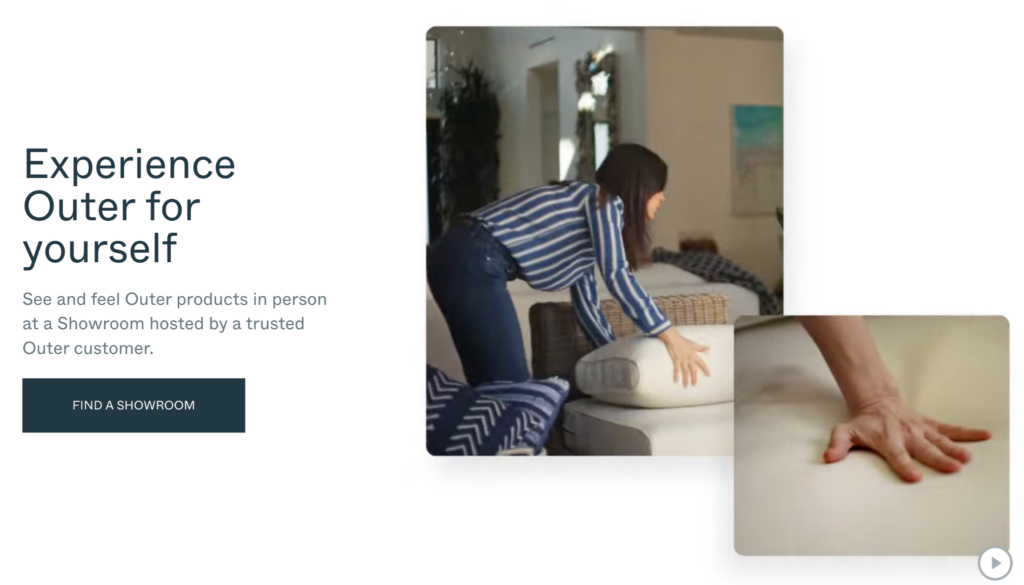Let’s face it: Most people don’t want to buy from a brand without any social proof or a product they’re not confident they’ll like, especially in an age where competition is fierce and new stores are popping up daily. Building trust with your customers is crucial to growing your online business and gaining success in today’s saturated market.
User-generated content, online testimonials, and influencer marketing are all techniques ecommerce brands use to build trust and proof of product. But, it’s not always enough and still lacks the genuine experience of shopping at a classic brick-and-mortar store.
A new technique making ripples across the industry fills this gap by offering prospective shoppers an interactive and authentic consumer experience. Interactive customer testimonials allow interested shoppers to engage with a brand’s product in the flesh while connecting with like-minded people.
As CEO and Founder of Moast, a company paving the way for this new form of social proof, I’ll discuss how interactive customer testimonials can lead to the growth of like-minded communities, trust in your brand, and ultimately higher revenue.
How Do Ecommerce Brands Build Social Proof?
Social proof isn't a new concept to ecommerce but an age-old practice to help customers feel confident purchasing.
Here are some of the more common ways that brands have built their social proof:
User-generated content (UGC)
User-generated content, or UGC, is created by real brand customers. It is generally content created by the customers and uploaded online, either through a social platform like LinkedIn and Instagram or even sent directly to the brand itself. UGC can come in various forms, like podcasts, images, videos, or written pieces. Think unboxing videos and reviews or a blog review posted by happy customers looking to share their experience with the product and brand.
A great example is Crumbl Cookie, a brand that took off on TikTok from users trying their weekly cookie flavors and reviewing them on the platform.
Social testimonials
Social testimonials are another form of content created and posted by customers providing feedback on the product and brand.
Testimonials may be collected feedback from an email campaign or a review on your company website that details their experience with your brand and its products. Positive testimonials can go a long way toward shifting buyer attitudes and building strong social proof.
Influencers
Influencers have built a following of engaged people across social media channels. They are often authority figures within a niche that can influence the purchasing decision of their viewers.
For example, Australian beauty influencer Chloe Morello has sold multiple products by using them on her TikTok or YouTube channel.
VR trials
VR trials are another neat way that brands have made it possible for prospective customers to experience and try out their products. One popular example comes from glasses and sunglasses brands that allow you to try on glasses through your camera to see how they would look on your face.
UGC, testimonials, influencers, and VR trials can all be great ways to get eyes on your product and build trust, but they still lack the true experience of brick-and-mortar stores that allow customers to see their product firsthand.
Fortunately, interactive customer testimonials have solved this issue, allowing customers to visit their desired product in person and speak with actual customers of the brand in question.
What Are Interactive Customer Testimonials?
The techniques listed above greatly encourage shoppers to feel confident in purchasing.
However, they still fail to eliminate the personal and authentic connection from physically engaging with a brand's product. Five-star reviews and video testimonials can only give a partial view of a product and don't always convert prospects into paying customers.
Brick-and-mortar stores are a costly endeavor with a high barrier of entry for growing brands that typically lack the financial capacity to open up physical locations. Yet, they are still an attractive option to shoppers who crave genuine and physical interactions with the things they purchase.
Interactive customer testimonials are the trend and the next step that eliminates this barrier and enables ecommerce brands to grow an engaged community of like-minded people while showcasing their products to interested parties.
The process involves using existing customers as “hosts” or representatives that connect with other locals in their area to discuss the products they purchased and arrange in-person meetings for viewings, whether it might be furniture or sporting equipment.
As a result, prospective customers get to have authentic experiences with the product and engage in conversations with people who love the product and know the brand.
Why Should You Consider Interactive Customer Testimonials?
The perks to implementing interactive customer testimonials into your ecommerce strategy are plentiful, but I’ve narrowed it down into three key drivers that might influence your decision:
Increases trust in your brand
More and more companies are realizing that consumers don’t always trust brands but prefer to rely on each other when making purchasing decisions, proven by the tremendous rise of influencer marketing we’ve seen in recent years. We see it everywhere, from 15-second video reviews on TikTok to 1000-word articles on niche blogs.
Interactive customer testimonials take this one step further by enabling two-way conversations between potential customers to communicate and ask questions from real, paying customers that know and love the brand and its products.
As a result, customers can openly share their concerns and questions with existing customers while testing out and seeing the product with their own eyes.
Builds social proof
Did you know that 91% of shoppers will read at minimum one review before purchasing a product or that 80% of U.S. shoppers seek recommendations before making a purchase?
Social proof helps to show that the product will perform as it’s supposed to and that others have already used and enjoyed the product themselves.
Interactive customer testimonials take this a step further and eliminate any concerns a shopper might have over slanted reviews by allowing them to engage with and hear from existing customers in person or virtually in real time.
Builds stronger relationships
By connecting with existing customers, shoppers grow to trust the brand and form relationships with other individuals, leading to the growth of a community of engaged and like-minded people.
Brands benefit from reduced churn rates and existing customers actively promoting their products for them.
3 Brands That Are Doing It Right
As the trend grows, more brands adopt this approach in their ecommerce strategies to stay ahead of the curve and outperform competitors.
Here are three examples of brands that have successfully used interactive customer interactions to grow their business.
Oru Kayak
Oru Kayak is a popular outdoor brand featured in Forbes, Shark Tank, and the Wall Street Journal. They created portable kayaks that adventure-seekers could use to explore the most remote and difficult-to-reach places with their watercraft.
In marketing their product, they saw an opportunity in the market by looking for a way to help kayakers connect. This led to building the interactive platform that onboarded existing customers as Oru Explorers and allowed prospective customers to engage and communicate with them through the brand’s online platform.
They also launched an interactive map showcasing where Oru Explorers were located so potential buyers could connect and exchange information with a request to view the product in person before making a purchase.

Outer
The furniture brand Outer and its CEO Jiake Liu are another example of a brand that successfully used interactive customer reviews to build brand authority and drive sales. Outer launched “Neighborhood Showrooms,” a platform enabling customers to experience the product in person before purchasing.
The platform allowed prospective customers to request appointments with local hosts to view the furniture in person and how they had it displayed in their homes. Additionally, many hosts uploaded pictures of their displays, allowing Outer to collect tons of user-generated content.
Outer has since had thousands of neighborhood showroom visits and cultivated a community of engaged people who boast about their brand's quality. They did it by creating a platform that allowed customers to have authentic experiences with their brand and its products.

Merkava eBikes
Merkava is another company that has followed suit, having onboarded the Host program and using interactive customer testimonials to sell products and build brand authority. They offer bikers the incentive of earning extra cash for each visit they book to display their bike to other prospective customers.
As a result, Merkava is seeing a growing base of bikers that enjoy talking about the brand and everything they love about their Merkava bikes.

How Can You Get Started With Interactive Customer Testimonials?
Social proof and positive reviews can go a long way towards building trust in your brand and its products, but it’s not always enough. It still doesn’t offer prospective customers the authentic experience of genuinely seeing a product in person.
A platform like Moast offers ecommerce brands the opportunity to build interactive customer reviews on their website easily. The platform seamlessly integrates into your website with just one line of code, ensuring the entire experience stays on your site.
We like to break it down into four easy steps to getting started with building your community:
- Strategize: Define goals and a program that fits your brand.
- Launch: Onboard customers and build interest through email campaigns.
- Integrate: Install the customer review widget into your platform to make it easy for shoppers to find and connect with your growing community.
- Grow: Watch your community evolve and grow with the help of Moast.
Stay Ahead Of The Curve
Authenticity continues to be a prominent aspect of ecommerce success, and interactive customer testimonials are one of the newest drivers of change used by popular brands today.
Don’t stop the growth today, and consider checking out some other ways to personalize your ecommerce brand and stand out in 2023.
Subscribe to The Ecomm Manager newsletter to stay ahead of the curve and up-to-date on all the growing trends in ecommerce, marketing, logistics, and more.
More great ECM content:
- What Is Social Commerce: 6 Best Practices To Ride The Wave In 2023
- How To Use Social Media For Ecommerce: An Easy Guide
- Why Ecommerce Influencer Marketing Is A Must-Have Strategy For Your Business
- 8 Ecommerce Trends Driving The Future Of Online Shopping in 2023
- 7 Retail Ecommerce Trends In 2023: What To Expect
- Top 10 Ecommerce Technology Trends For 2023
- 10 Best Social Commerce Platforms In 2023


